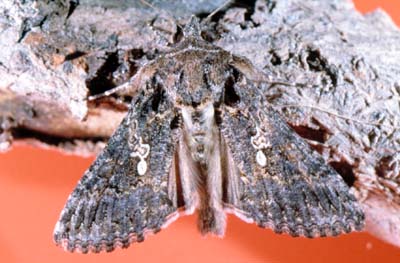
Cabbage looper, Trichoplusia ni, adult.
(Photographer: J. Capinera, University of Florida)
Vegetable crops that are commonly attacked by the cabbage looper include broccoli, cabbage, cauliflower, collards, mustard, radish, turnip, watercress, beet, cantaloupe, celery, cucumber, lima beans, lettuce, parsnip, pea, pepper, potato, snap bean, spinach, squash, sweet potato, and watermelon. Larvae feed on the underside of the leaves and may cause a netted appearance or may chew large holes in the leaf depending on the age of the larvae. There are several natural enemies that attack the cabbage looper and a nuclear polyhedrosis virus help keep populations at low levels. Many sampling strategies are developed for cabbage looper, including blacklight traps and pheromone traps. Insecticides may be used but resistance has become a problem with many of the chemicals used. Bacillus thuringiensis is a common biological control agent used to suppress cabbage looper populations. Cultural control practices include row covers, crop rotation, destruction of crop residues and alternate hosts, and the use of resistant varieties.
Images
To save the Web-optimized images shown below to your hard drive:
|
Click to access Display and Print quality images. |
|
Click to access Display and Print quality images. |
|
Click to access Display and Print quality images. |
|
Click to access Display and Print quality images. |